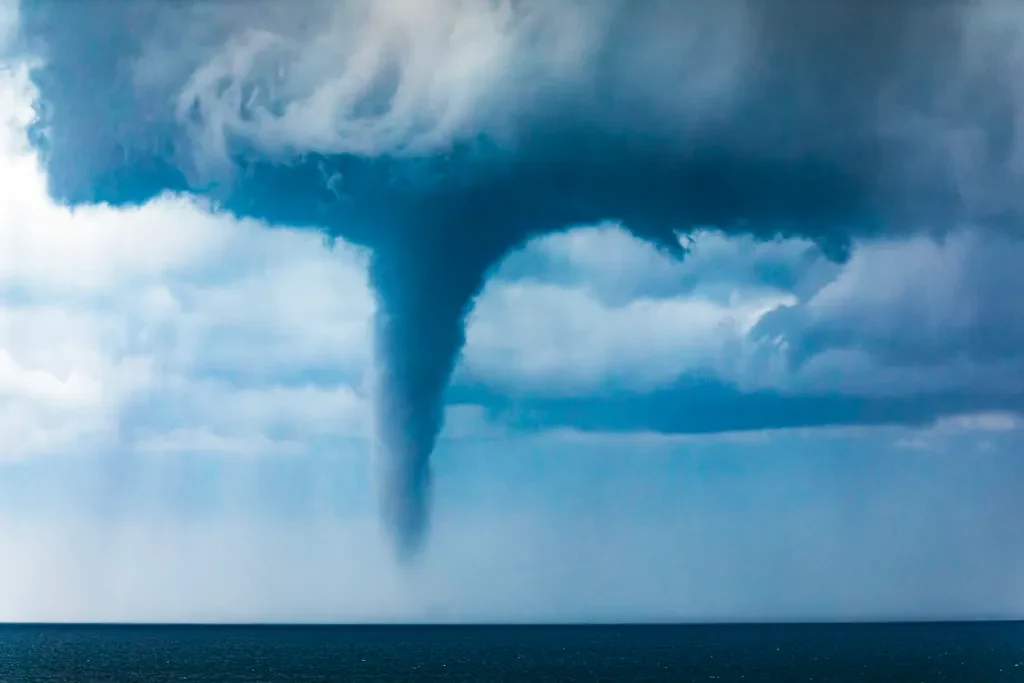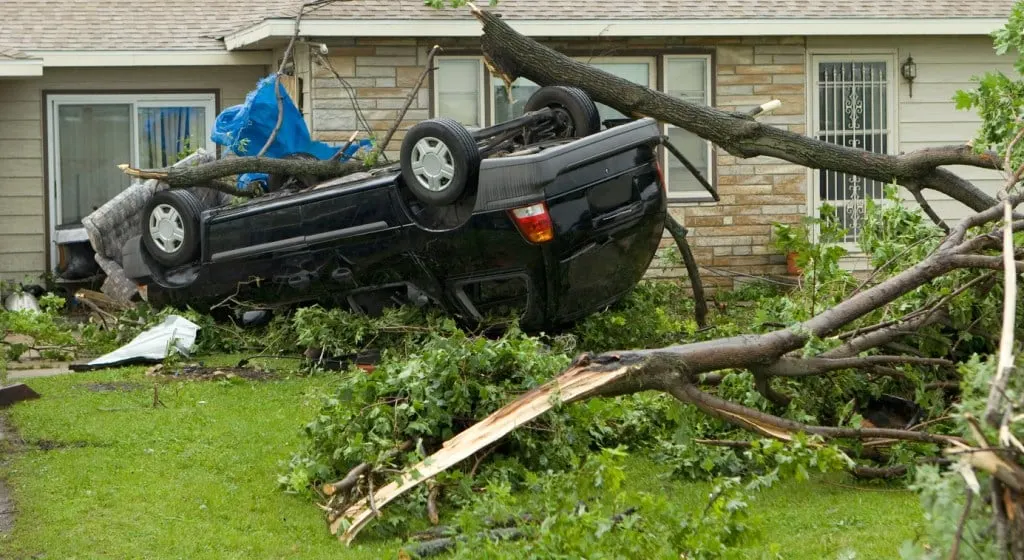No one wants to be caught in a tornado, so you must act fast when you hear there’s a watch or warning in your area.
However, it’s easy to be overwhelmed in the moment. Preparing for inclement weather before it strikes can keep you calm and focused when it inevitably happens.
Today, we’re giving you ten tips to help you through your next tornado watch.
Let’s roll!

About Tornado Watches and Warnings
Of all Mother Nature’s powerful manifestations, tornadoes are one of the most violent. These swirling columns of air stretch from thunderheads to the ground, often in flat, open areas. In fact, Texas sees more events than any other state. Oklahoma, Arkansas, and Louisiana follow closely behind.
But these storms can strike just about anywhere. And, unlike hurricanes, they don’t offer much warning. Instead, they can appear at a moment’s notice. Springtime is peak tornado season, with about 70% of reports taking place between March and June.
Tornado watches happen when conditions are favorable for forming these forceful cyclones. This often occurs when thunderstorms like supercells are already present. Unstable airmasses begin circulating, and wind shear strengthens these movements.
When an actual funnel develops, we get a tornado warning. At this point, it’s likely too late to prepare. You’ll need to seek shelter immediately. After all, twisters can reach wind speeds of over 200 miles per hour.
In order to keep yourself and your family safe, it’s best to plan ahead. Here are some of our top tips to help you out the next time you’re in the danger zone.
#1 Go Over Your Family’s Safety Plan
Having an emergency preparedness plan is crucial for your family’s safety. It tells you where to go and what to do in a crisis. But if you wait to think about this information when disaster strikes, it’ll be too late.
This document should include contact information and medical details for your family members, safe places to shelter in your home, and designated meeting spots in case you’re separated during the event. It should also contain a list of urgent supplies and items to grab on your way out the door.
Be sure to add phone numbers for your utility company, water supplier, and other essential providers, as well.
#2 Find a Safe Place to Ride Out the Storm
Where you choose to shelter during a tornado can make the difference between life and death. Experts recommend low-lying interior rooms like a basement. If your home doesn’t have this feature, pick a spot on the bottom floor as close to the center of your house as possible, preferably without windows. A bathroom or closet might be your best option.
Of course, tornadoes don’t always strike when it’s convenient. You might be at work, school, or running errands when the alarm sounds.
If you’re in a large building like a shopping mall, hospital, or church, get to the lowest floor and seek out an interior room. Some facilities have a designated shelter that an employee can help you find. Otherwise, see if you can locate a cement stairwell and head to the bottom.
Folks in RVs, mobile homes, or portable classrooms should go to a more secure building to hunker down. These structures aren’t made to withstand high winds. In fact, it’s better to find a ditch or ravine outside than try to ride out a tornado in a trailer.
If you’re in this situation during a tornado warning, lay flat on the ground and put your hands over your head for protection.
#3 Charge Your Devices
When you hear that your area’s under a tornado watch, one of the first things to do is ensure your phone has a full battery. Most of us use our phones to stay up to date in emergencies, and it could be your lifeline in a worst-case scenario.
Plan ahead by keeping a spare charger in your bag or car at all times.
It’s also wise to have a backup battery charger. You can snag one at a big-box store for about $20, and they’re a lifesaver when the power goes out.
#4 Reach Out to Friends and Family
Tornado watches are an excellent opportunity to check in on your loved ones. Maybe you have a family member who lives alone and might not know to be on alert. Give them a call to fill them in and ensure they have a safe place to go in case of an emergency.
It’s also a good idea to contact other friends and family so you know where everyone is. Whether the kids are out with friends or your significant other is running errands, you’ll want a general idea of their location if a tornado watch becomes a warning.
We’ve probably all been in this situation before. You hear about a tornado touching down, or maybe a tragic car accident, and suddenly you can’t get in touch with your family. You’ll know where they are by communicating beforehand, so you don’t have to worry.
Turning on your location services can also provide some relief for those who care about you.
#5 Pack an Emergency Go-Bag
Once you determine that your family members are safe, it’s time to pack a go-bag. This should include essential supplies like flashlights, batteries, water, and snacks to give you energy. If you suspect you might take a direct hit, throw in a few cans of non-perishable food and a can opener.
Be sure to pack any medications you or your loved ones might need, as well as antihistamines, Motrin or Tylenol, a first-aid kit, and a weather radio.
One change of clothes per person is usually plenty. You’ll want to grab toiletries, such as toothbrushes, toothpaste, and deodorant. After all, being stuck in a storm shelter is bad enough without everyone smelling like week-old tacos.

Other useful items to consider are trash bags, duct tape, and a pocket knife. Grab your identification and any essential documents like birth certificates. If you can get to things like mortgage paperwork, insurance information, and banking details, add those to your bag.
Finally, remember that you’re hoping for the best but planning for the worst. It’s better to have it and not need it than need it and not have it.
#6 Secure Your Pets
Our four-legged friends love spending time outside, but it’s essential to have a plan for them when foul weather strikes.
Of course, the best place for pets during a tornado warning is in a low, interior room with you. However, sometimes that’s impossible. If your family’s sheltering in a small powder room, you might not have space for Fido.
If that happens, designate a safe spot for them where they feel secure. This might be a crate or other small room without windows. Give them food, water, and an extra treat. Another way to make them more comfortable is to leave them with a blanket, towel, or shirt that smells like you.
Bring horses and other livestock into a barn or shelter right away.
Tornadoes aren’t the only natural disasters to watch out for! Ford Truck Rescues Camper in Flooded RV Park
#7 Keep Your Weather Radio On
While many of us check in to our local news channel to stay up to date on tornado watches and warnings, reliable service isn’t guaranteed. Unfortunately, this is especially true during severe weather. That’s why a portable weather radio is crucial.
These devices usually run off of multiple power sources. For example, it might take batteries and have a hand-crank so you can charge it manually. Some might even work with solar energy. In any case, weather radios can provide information straight from the National Weather Service and don’t rely on cell service or an Internet connection.
Plus, you’ll have peace of mind knowing that if the batteries die, you’ll still be able to get vital updates.
#8 Avoid Driving
Vehicles are among the worst places to ride out a tornado. Sure, outrunning a tornado in your car doesn’t sound too hard, but that assumption could be deadly. After all, these cyclones can be miles wide and travel up to 50 miles per hour, with internal speeds up to 200MPH.

If there’s a tornado watch while you’re on the road, pull over and find the nearest storm shelter. Your local Emergency Management Agency can help you locate one in your area. If that tornado watch becomes a warning, you’ll be happy to have the information.
Remember that bridges and overpasses aren’t safe places to hunker down during these events. Despite the iconic scene from the 1996 movie Twister, they don’t provide a refuge from violent tornadoes.
Seriously, find a shelter: Tornado Causes RV Driving Fatality on State Highway.
#9 Keep an Eye on the Sky
While it’s always smart to listen to official reports when there’s inclement weather, knowing what to look for in the clouds is helpful, too.
In the early stages, you might see dark, low-hanging clouds. Areas of rotation and funnel-shaped formations may develop. Sometimes, you’ll also see debris circling near the ground below.
Other signs of an impending tornado to watch out for are the sky turning a deep greenish color and either a loud train-like roar or an eerie silence during or after a storm. Occasionally, large hail will fall before a funnel touches down.
A NOAA emergency radio with solar, chargeable, and crank options is an excellent tool: Emergency Hand Crank Radio with LED Flashlight.
#10 Don’t Assume You’re Safe
The aftermath of a tornado can be dangerous, too. After one of these monsters moves through your area, you might be tempted to head outside and assess the damage. However, it’s critical to wait until the threat is over. Keep your weather radio on and listen to ensure you’re no longer under a tornado warning.
When you do go out, wear sturdy, thick-soled shoes and watch your step. Debris often includes nails, broken glass, and electrical wires. Assume any power lines are active to avoid a deadly shock.
Finally, steer clear of any buildings that may have been damaged during the storm. Even if it looks structurally sound from the outside, the inside could tell a different story.
A Tornado Watch Could Be Your Only Warning
Although tornadoes don’t provide much warning before they strike, there are signs to watch for and steps to take to keep yourself and others safe when they touch down.
Whether you live in places where they’re common, or you’re just traveling through, you’ll want to be prepared for anything. Go ahead and stock up on emergency supplies and establish a safety plan. That way, you’ll have a leg up when tornado season rolls around!
We’ll Help You Find the Best Free Camping in the USA
You should give it a try!
As a matter of fact, these free campsites are yours to enjoy. Every time you pay federal taxes, you’re contributing to these lands.
Become a FREE CAMPING INSIDER and join the 100,000 campers who love to score the best site!
We’ll send you the 50 Best Free Campsites in the USA (one per state). Access the list by submitting your email below: